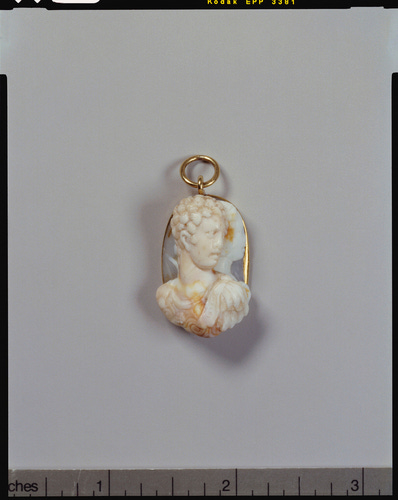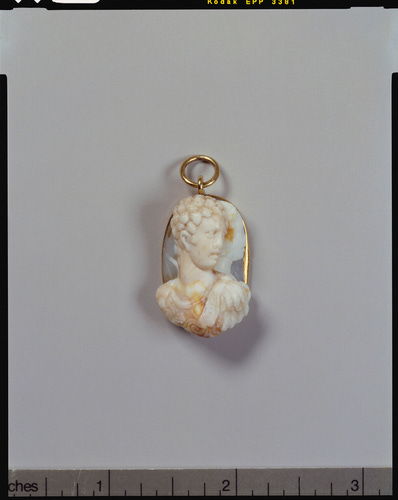Prepare for Trouble, Make me Double
Elagabalus and the Double portrait
This wonderful piece of bling is owned by none other than ol’ sausage fingers himself, King Charles III. It’s a miniature or cameo of the only trans woman to rule the Roman Empire, Elagabalus (reigning 218 - 220 CE)
✨ Experts ✨ say this is of Elagabalus and her mother, but I’d suggest smth slightly different. I’d suggest it could be Elagabalus with her post-transition self.
Now for anyone freaking out at the idea of Elagabalus being trans there is evidence straight from the horse girl's mouth - she offered half the empire to anyone who could give her a vagina and she banished anyone from court who misgendered her on purpose. So we can say with some certainty that she was a trans woman.
Why do I suggest that it is a double portrait of her? Cuz there are plenty of art historical depictions of trans people in a similar way, and Mannerists had a habit of wanting to flirt with the grotesque and what is more grotesque to society than the image of a trans woman? (Don’t answer that)
Let’s look at some other pieces to see how this could indeed be a double portrait of the estrogenically-challenged Empress herself.
Janus and other double deities
The first i want to look at is the double faced busts of Janus, the Roman deity of doorways and transitions (lol). Transitions being originally meaning like the changing of seasons and going from life to death etc. but with the invention of us modern transsexuals we can take that a little more literally if we want
While there aren’t too many depictions of Janus dual-wielding genders in Elagabalus’s time - it seems to have become more of a thing in 1700s - there were still plenty of busts and depictions of Janus as an older man with a beard and with a 2nd younger shaven face, which could have lead to the interpretation of Janus having 2 different gendered faces, particularly as gender stereotypes began to become more rigid and weird over time
The one above I would read as two different gendered faces but everyone can make their own mind up.
Some are even shown as just the same face twice but no matter which way it is all about the duality of man (or in our case the duality of tran).
Interestingly coins with Janus on seem to fall more out of fashion as we begin to approach Elagabalus’ reign with the latest dated one in the British Museum’s collection and that I could find was around 211 CE, so 7 years before Elagabalus becomes Empress. I’m not here with my tin foil hat on screaming conspiracy, its just an interesting observation that imagery symbolising duality and transition was being phased out just before the singular trans empress (that we know of) was installed
The two-faced depictions aren’t only limited to Janus though as there are plenty for other deities such as this bust of hermes and a maenad from the 1st century CE
So we can see that the double portrait (and the idea of duality in beings) goes back to before Elagabalus’ time. I even stumbled on an example in my local museum of Apollo and Diana from Lanuvium in Italy.
Even in 400s CE there were theories by Macrobius that Janus was actually a combination of the deities Apollo and Diana, so this idea of dual-wielding genders is also happening in the time of the Roman empire, so the idea of a double portrait of Elagabalus isn’t so much of a reach
Double D’Eon
The second comparison we should look at is more contemporary to the pendant itself - La Chevaliere D’Eon
She was a french intersex trans woman who was also a spy, soldier, diplomat and expert swordmistress who was definitely known to King George III, who bought the cameo in 1762, around the same time D’Eon appeared at court and became friends with his wife, Queen Charlotte
D’Eon was depicted in many ways but this was how cis ppl chose to symbolise her transness. I could go on about how this is a transphobic way of depicting her but its also one of the ways we can see her transness represented in art sooo 🤷♀️
I think rather than considering it to be about ~ the duality of gender ~ it could just as easily symbolise everything else such as her changing roles, jobs or even allegiances. Going from captain of french dragoons to english socialite aristocrat is a leap in roles even without all the gender stuff
D’Eon was a celeb of the time cuz transness and being intersex was smth that was fetishised as hell and deffo as much as a curiosity for cis ppl then as it is today - if u look at many details of her life u would see that not that much has changed in the way we are treated
So we can see the double portrait being used even 260 years ago for other trans women to show different aspects of our lives, and yes primarily to do with gender cuz cis ppl are obsessed
Doubling Down: Before and After photos
As we can see in the previous section the double portrait has been a staple of showing transness for centuries, but it’s not just a quirky way for the cis to take the piss out of us; we as trans ppl use it ourselves. Often used to show the difference physically when medically transitioning ppl will gleefully do a #TransformationTuesday post showing how different they look from pre-hormones and other medical and social interventions to now.
Good.
As much as it’s not my thing I don’t begrudge ppl doing it, whether for their own self-esteem or to help more recently hatched trans women who are considering medical transition etc.
I’m not going to use any images in this section cuz personally i don’t feel comfortable with that but if u really need an example here is a pinterest board.
While a lot of these pics aren’t the exact same style (a very voldemorty 2 faces on one head) we can see the progression from the Janus heads, to D’Eon to our modern usage. Looking to the past and looking to the future (or rather the present with a view of the future) is still a major theme in all of these, as is the obvious theme of transition, beginnings and endings. We could even look at Janus’ as the deity of doorways and particularly stepping in and out of the doors of homes as a theme that aligns with transness as a lot of trans ppl do have to leave home due to being trans and have to find or build ourselves new ones.
Make it Double: Unpacking the cameo itself
So let’s finally get back to the cameo itself
The cameo is made of carved seashell and sits on a gold mount with a suspension loop at the top, showing that this was likely intended as some sort of pendant or charm. The cameo itself however is from an earlier time than the mount which means it was probs not originally gonna be a pendant but this could have been on a framed base or even a relief carving from 16th century that was then decided to be made into a pendant for someone in 18th century (cuz the georgians were surprisingly big on recycling)
The provenance (the history of it) we are given is just that it was in Consul Joseph Smith’s collection in Venice and was then bought by George III, which tells us next to bugger all about it really.
I emailed the Royal Collection Trust who sent me a link to a latin text (cuz ofc they did 🤦♀️ thanks Dr Kit Heyam for translating for me) from 1767 which suggests that the cameo itself, but not the mount, was excavated in Chalcedon - which would later become part of Constantinople, and then modern-day Istanbul - so it would likely have been excavated in the 2nd half of 1500s and eventually made it’s way into Smith’s collection
Other than this there is no information on when it was likely carved but if this is of Elagabalus then we are looking at 218 - 220 CE as that is when she ruled and it is usually during the ruler's reign that memorabilia is made of them.
So what could make this a double portrait?
Well it’s all in the interpretation, and what else is art for than to wildly interpret it in new and exciting ways.
Using the examples we already talked about we could compare it to a Janus head - both faces are lookin in different directions even tho they are facin the same way, and we can’t see that they are not joined somehow.
I’d say that the face at the back looks softer and more feminine, that could also be that that face hasn’t been as exposed as the one at the front, but that idea of contrast works in line with both the portraits of Chevaliere D’Eon and the modern transition photos.
The face at the back looks away from the viewer, avoidin eye contact in a similar way we see in Hermaphroditus status and carvings from antiquity, and has a much more serene expression as opposed to the face at the front, which looks more stressed than anything else. This could also be read as part of the double portrait and I’m sure many other trans women than just me can identify with a much more serene feeling after transition compared to their stressed pre-transition selves.
The latin text was not 100% sure it is a depiction of Elagabalus, also suggesting that it could be a carving of Apollo and Diana - which would support Marcobius’ theories about Janus from the 4th Century and leave us with another reason why this could be a double portrait.
I’m not going to demand the cameo be viewed only in this context cuz she was trans cuz i really don’t care how cis ppl wanna view it; cuz they are always gonna see things in a different than me, but its nice just for a little while for someone to see the view from over here cuz it really is quite beautiful.
*This piece of writing had been submitted to an online classics magazine but i never heard back from them i guess everyone has to write a stinker every now and then 🤷♀️
If u wanna support a disabled transsexual in her artsy rambling u can tip me on Ko-Fi here:
Subscribe to GossipGrrrl for more artsy ramblings:
Follow me on Instagram:







